MENU
MENU
Tea production area: Kiryu City and Shibukawa City
Brand name of tea: Umeda tea and Komochi tea
Types of tea: Sencha (medium steamed green tea), hojicha (roasted steamed green tea), powdered tea and black tea
Umeda tea
In Umeda Town, Kiryu City, farmers cultivated tea for their own use from tea plants that were previously used as hedges. Umeda Town is located deep in the mountains and is suitable for cultivating tea because streams of clear water flow and fog is generated.
After World War II, tea cultivation was recommended, and a tea factory was built by the local farmers’ cooperative association for commercial use. However, the tea industry gradually declined.
When the association was dissolved, Mr. Tomoyuki Inaba took over the tea factory. He established the company Gunma seicha in order to preserve Umeda tea.
Currently (as of Feb. 2022) about 150 farmers cultivate tea. Their tea leaves are produced in the tea factory of Gunma seicha and sold as Umeda tea.
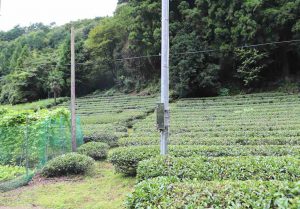
Tea fields in Kiryu City (September 2019)
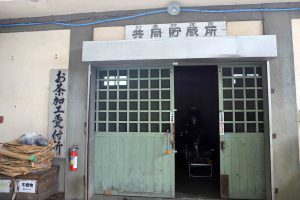
Gunma seicha (September 2019)
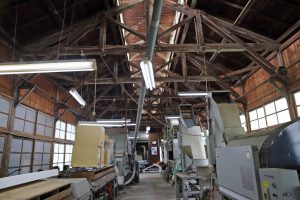
Tea factory of Gunma seicha (September 2019)
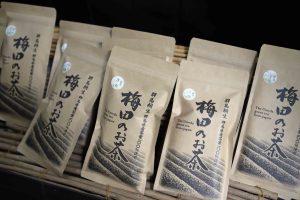
Umeda tea (sencha) (September 2019)
Umeda tea and mulberry tea
Mr. Inaba realized that due to the aging of tea farmers, in the future it would be difficult to maintain the tea factory only by producing tea. Thus, he began producing mulberry leaf tea as a new business.
In Kiryu City, the textile industry has been thriving for some time, and silk fabrics have been a local specialty of Kiryu City. The preferred food for silk worms, which produce the raw material for silk thread, is mulberry leaves. In Kiryu City, there are still many mulberry trees in good condition. Gunma seicha produce mulberry leaf teas (leaf type, roasted leaf type and powdered type) and sell them.
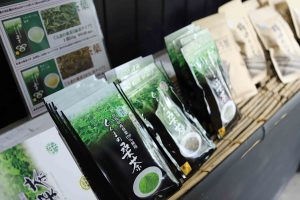
Mulberry leaf tea, Gunma seicha (September 2019)
The taste and appearance of tea leaf (Camellia sinensis) and mulberry leaf tea are similar yet different. Umeda tea has full body and rich taste with mild bitterness. On the other hand, the mulberry leaf tea has less bitterness with a slight viscosity.
Both Umeda tea and mulberry leaf tea are sold at Gunma Seicha, Umeda Furusato Center, Kiryu Station, etc.
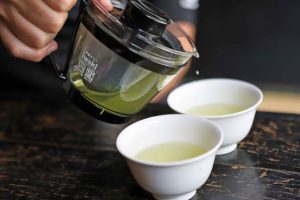
Sencha “Kiri” of Umeda tea (September 2019)
Komochi tea
Komochi tea has been cultivated and produced in the former Komochi Village of Shibukawa City. Now not only sencha, but also black tea is produced. Due to the aging of tea farmers, it is difficult to maintain the tea factory only by producing tea. Thus, Gunma seicha manages the tea factory now.
Jyoshu Shirakubo no Ochako 上州白久保のお茶講
Ochako is similar to Tocha (闘茶). Tocha is a tea guessing game where people drink tea and guess its place of production and brand name. Tocha was transferred to Japan from China (Sung Dynasty) at the end of the Kamakura Period, and it was in fashion among the nobles, monks and samurai in the Muromachi Period. It was also called Chakabuki (茶歌舞伎).
Jyoshu Shirakubo no Ochako (tea ceremony) has been held every year on February 24,
when a small festival is held ibefore the Tenjin festival n Nakajo Town, Azuma County.
In the Ochako, 4 types of blended tea using dried mandarin orange peel, powdered sencha (steamed green tea), etc. are made, and people drink the teas and guess which one it is. The Ochako was designated as a significant Intangible Cultural Property in 1990.
Related article on the site:
Tea related facilities:
ぐんま製茶 https://gunma-seicha.com
梅田ふる里センター http://park15.wakwak.com/~furusato/
道の駅こもち https://komochi.com
Tea mascot Yuru-Chara:
Ceramic and pottery art: Shibutami ware
Reference:
松下智 (平成3年) 日本名茶紀行 (初版) 雄山閣出版
高野實、谷本陽蔵、富田勲、中川致之、岩浅潔、寺元益英、山田新市 執筆 (社)日本茶業中央会監修 (2005) 緑茶の事典 改定3版 柴田書店
*The information provided on this site may be updated. If you find any information in this article that is incorrect, new, or incomplete, please contact CHAMART.
*The site does not describe all “Teas of Japan” or all “Teas of the World”. Additionally, each article expresses the writer’s personal experience and feelings.
#umedatea #umedatea #gunmaseicha #kmochicha #komochitea #greentea #tealover #enjoytea #japanesetea